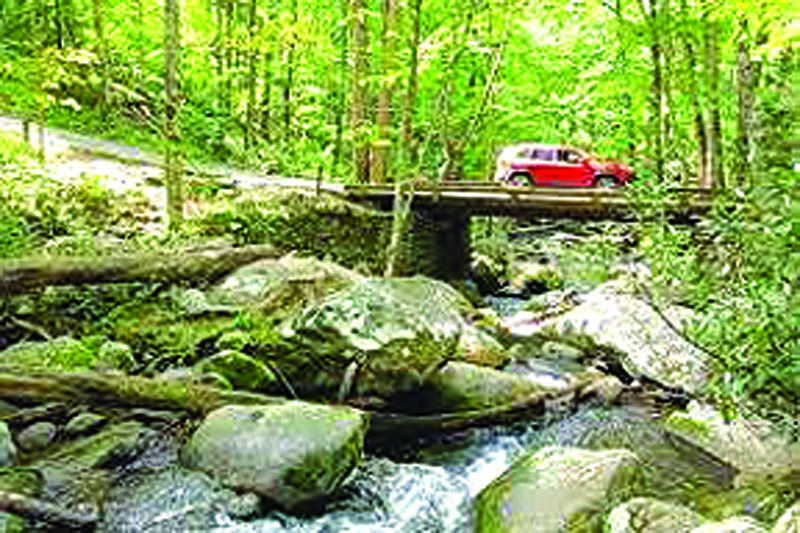Hell, fire, and brimstone
From the Mountains

Roaring Fork in Southeast Kentucky
Daniel and his wife Catherine raised their family of eight sons on a large tract of mountain land at the head of Lost Fork of Stinking Creek after the war.
Franklin Gambrel married Louisa Carnes and they had a family that included four sons. They lived on a large tract of mountain land at the head of the Kinningham Branch of Stinking Creek.
The property of the two cousins intersected on the ridge of the mountaintop and their sons often played and hunted together. They became educated in the mountain ways of survival and self-reliance.
Daniel’s son Green Gambrel repaired a pistol for Franklin’s son Garrett Gambrel. A faulty trigger spring was used and an argument ensued, an argument that resulted in violence that drastically affected both families. Garrett ambushed his cousin shooting him through the head. Green’s brothers, Allen, Rice, Tom, Silas and Nelson, vowed revenge.
A coffin was delivered from Barbourville and Green Gambrel was laid out in the home of his parents.
During the wake, to everyone’s surprise Green came back to life. Often in that era mountain folks were not embalmed and Green lay in a catatonic state before reviving. He hung onto life by a thread for days. At first he was bedridden, incoherent and in a pitiful state. He eventually improved however although he had some paralysis in his arm and leg for the remainder of his life.
His coffin was stored in their barn and at times he would amuse visitors by lying in it. Green and his friends would often gather around the coffin and use it as a card table.
On a hot summer day in 1907 Green Bingham, a Methodist minister was holding services at Roaring Fork school house. A large crowd arrived by wagon and by horseback while others came on foot. The building was filled to overflowing with many others listening from outside. Brothers Allen, Rice, Tom, Silas and Nelson Gambrel were present, armed and expecting trouble.
The Rev. Bingham was preaching his sermon when John, son of Franklin Gambrel, arrived on his horse. As he dismounted Allen threw a rock that barely missed John’s head. An altercation was averted as the men in the schoolyard kept Allen and John apart.
They helped John into the building through a side window and he made his way to the center of the congregation. Everyone was surprised and aghast when a blast from a gun filled the room, disrupting the service.
The shot accidentally struck Rice Bingham in the leg. “Rice has been shot,” someone yelled. Allen Gambrel was still outside. When he heard Rice had been shot he immediately thought it was his own brother Rice who was hit.
Allen ran inside and began shooting at his cousin John who then returned his fire. Pandemonium ran rampant as churchgoers ducked behind seats while others lay on the floor as loud blasts from the guns echoed through the small school house. The disturbance ended abruptly with John Gambrel lying dead with four bullet wounds. Allen Gambrel was much more fortunate. Although he suffered no injury a bullet passed through his hat actually parting his hair.
Allen was whisked away from the schoolhouse by his brothers. After making quick preparations he fled Kentucky to evade retribution from his cousins or prosecution by the law.
After several weeks Allen Gambrell wrote a letter to his family and the sheriff learned of his location from postal authorities. He was captured and returned to Barbourville to stand trial. It was a lengthy trial as it included a host of witnesses testifying for both the defense and the prosecution. Allen admitted during the trial that he shot his cousin John Gambrel claiming he fired in self-defense.
“After I heard the shot I stepped inside the building,” Allen admitted. “He fired a shot at me and it knocked the hat off of my head. I then shot him in self-defense.”
The verdict was guilty and the lanky Allen Gambrel faced life imprisonment in the Kentucky State Penitentiary. His attorneys appealed the case to the Kentucky Court of Appeals where he was granted a new trial. The lower court had erred in instructing the jury that the defendant could not rely on self-defense as a defense.
Three years after the first trial Gambrel again faced his accusers in the Knox Circuit Court in Barbourville. It was argued by the prosecution that Allen caused the shooting by entering the schoolhouse. Many witnesses agreed. Others said he had every right to attend the church service.
At the conclusion of the legal process “guilty” was again the verdict and life imprisonment was the sentence. Gambrel’s thoughts were of escaping as he waited to be transferred back to the penitentiary.
A young woman cooked meals and did other jobs in the jail at Barbourville. Gambrel saw her as his best opportunity to escape and began establishing a friendship with her.
“They will be transferring me back to the penitentiary soon,” Gambrel told her. “Put the jail key in a bucket of coal and we will leave this town together and never look back.”
It worked. Jeopardizing her own freedom she placed the key to his jail door in the bucket of coal and a few hours later he used the key to gain his freedom. The jailer Harris Davis slept through the escape.
Allen did not show up for the clandestine meeting he planned with the young lady who aided his escape. Instead he went to his brother’s home and then rode a mule from there to his father’s house where he discussed his plans for leaving and evading the law.
“Allen, it’s life! Never surrender,” his brother Tom said while handing Allen his 45-caliber pistol. “If you must die looking down the barrel of this 45, then do it but never surrender.”
Allen was seen later that night by a friend Will Swanson as he boarded a train. Swanson said he didn’t know Allen’s destination.
Gambrel had vanished into the night and was never seen nor heard from again. The jail passkey used in his escape wad found in a trunk years later by a family member.
Copyright Jadon Gibson 2023. Jadon Gibson is a widely read Appalachian writer from Harrogate. His writings are both historic and nostalgic in nature. Thanks to Lincoln Memorial University, Alice Lloyd College and the Museum of Appalachia for their assistance.


